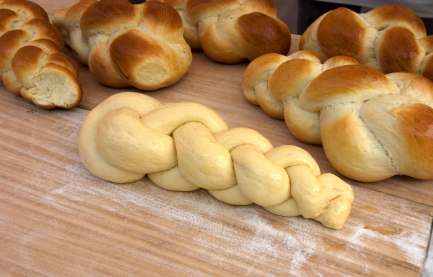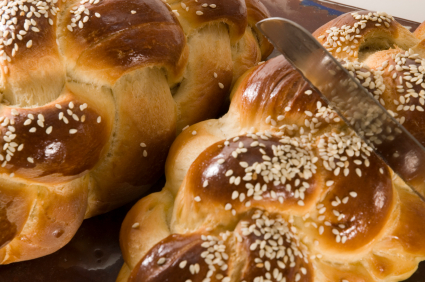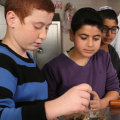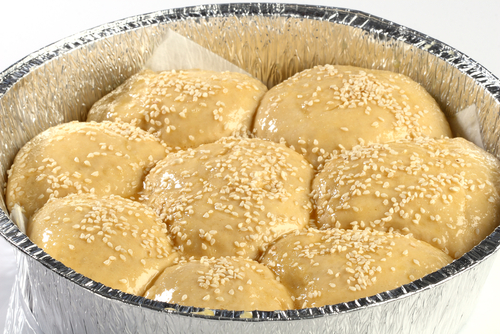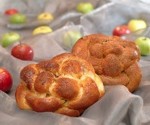Explaining Shlissel Challahs
This article first appeared in Hamodia’s Inyan Magazine, 2014
Question:
I know that the first Shabbos immediately following Pesach is what is known as Key Challah week, aka, shlissel challahs. What is this minhag all about? Doesn’t Hashem decree what we will make for the whole year on Rosh Hashana?
Question:
I tried making key challahs so many different ways but they come out looking anything but like a key. Any ideas you can share?
Answer to both qu’s:
The minhag to bake shlissel challah for the first Shabbos after Pesach is a long-standing one. To quote the Sefer HaTodah by R’Eliyahu Kitov: “The Shabbat after Pesach when we announce the coming of Iyar some…have the custom to make challah in the form of a key and to sprinkle it with sesame seeds. This is to remind us of the Mahn that fell in the desert and began falling in the month of Iyar; it also symbolizes that the ‘key’ to our parnossa is in Hashem’s hands. We pray that Hashem will open up his store of treasures and shower us with abundance.”
Sesame seeds are used to depict mahn as they are small and white as it says about the mahn, “they were like small seeds, white, and [tasted] as if they were dipped in honey.”
As for what is decreed on Rosh Hashana…a Yid always can use more bracha. We all want to pray that our parnossa comes through an easy and normal way, with no undue stress and hardship, so the extra tefillohs and brachos can only help.
I also interviewed Rebbetzin Sara Meisels (of Bobov) about this minhag and she had an additional background story to tell me about it:
There’s a beautiful story about the Maharal M’Prague that happened during the time that Klal Yisroel were persecuted relentlessly by non Jews with blood libels, r’l. After Lail Haseder, the Maharal was sitting and learning in his room at home; the key to the shul was with him, hung up in its place on the wall. The key suddenly fell to the ground. He picked it up and put it back on the hook. After it was hung up, it fell again. He picked it up once more. And then it fell a third time. This time he realized that Shomayaim was trying to tell him something, so he went to check the shul. When he got there, he saw that the paroches was moved out of place. He opened the Aron Kodesh and saw, hidden inside the Aron, what looked like a bottle of wine. After opening it he realized it was a bottle of blood; the non Jews were trying to set up a blood libel against them! Quickly, he pulled out the bottle, poured out the blood and rinsed it. He then poured wine inside instead.
The next morning the goyim burst into shul with the police, yelling and screaming. They went straight to the Aron Kodesh – obviously they knew where to go – and pulled out the bottle. The kehilla was very frightened but the Maharal was calm as he watched what happened next…the police opened it up and smelled it and it was only wine! They got very angry at the perpetrators and threw them in jail. Miraculously, the entire kehillah was saved. It was a huge hatzalah for the whole Jewish community.
Afterwards the Maharal wanted to do something to commemorate this special miracle. He knew that everyone bakes challah right after Pesach – especially in those years they had no other food besides the bread they made themselves – so he told his Rebbetzin to bake the challahs for that week, in the shape of a key. Afterwards, it became part of Klal Yisroel and their Kehilla for every generation. We also know that these ‘key challahs” symbolize the key to parnossa, as the Sefer Hatodah mentions.
So since nearly all of us want blessing for a good parnossa, we usually find a way to push ourselves to get those challahs done somehow, even after all the work of Pesach has just finished. I know of someone who would make extras and give it out to some of her neighbors to wish them a blessed year filled with parnossa tova…
There’s lots of interesting ways to make a key challah. I already have shown one in my Hebrew challah book and in a previous article I did for Hamodia over seven years ago; this time I’d like to try a new way. I saw this done by a lady named Sara E. who hired me to do a challah show for her whole family on Chanukah. In fact, you can even combine this with another minhag of having a challah that is made out of 12 pieces, a yud beis challah…
Take 12 smaller pieces of dough. Roll each one up into a small roll, whichever shape suits you. I liked the idea of them being small round flower-like shapes. You roll out the challah strand, and holding one end you make a small circle; the long end of the strand that you have left over, weave in and out of the hole of the circle three times, ending on the bottom of the roll. When these bake they will resemble a closed flower. Line up five of them in one row, with one or two rolls connected to the side of the second to bottom roll in this row.
This will become the bottom of the ‘key’.
The top part is very simple. Continuing where the top roll of the handle is, place the rest of the little rolls in a circle coming off of it. This is the top of your ‘key’. Now take a piece of baking paper that you squish into a ball shape OR a round small cookie cutter (and grease it with oil first so it wont get stuck inside the challah) OR use a piece of foil. Place this in the center of the circle so it will stay open.
Let it rise for 15-20 minutes and not longer. Too long and it will lose its shape. Preheat the oven; while it is heating, brush your challah with a beaten egg. If you make more than one challah, even better! Then sprinkle them with white sesame seeds and bake them at 375°F / 190°C. It should take about 20-25 minutes to brown to perfection on both the top of the challahs as well as the bottom.
When it is done, remove it carefully to a wire rack to cool, being careful that it should not break apart. Freeze it on a flat, lined cookie tray until hardened and them wrap it in plastic until the day of use. Or just shape it that Friday morning and then bring it directly to the table to await Hamotzi that night.
Just break off the rolls and serve. If you have more than 12 people at the table, I guess you will have to cut them up a bit more!
With warmest wishes for parnossa tova u’veshefa,
Tamar Ansh

